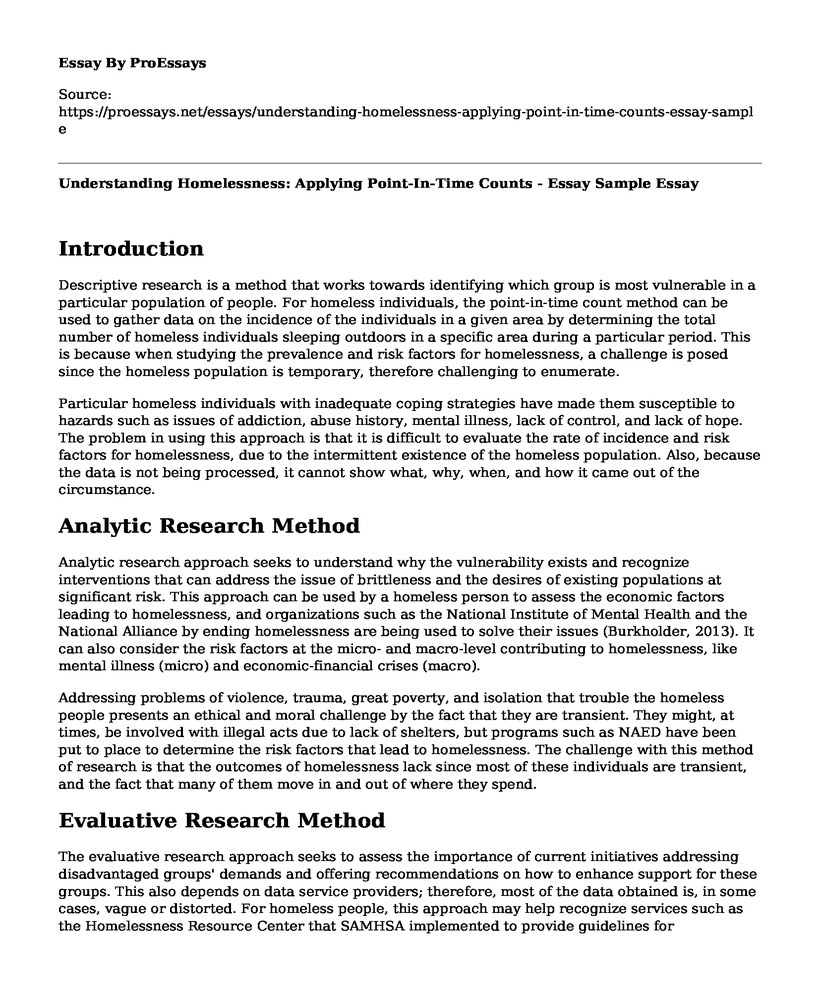Introduction
Descriptive research is a method that works towards identifying which group is most vulnerable in a particular population of people. For homeless individuals, the point-in-time count method can be used to gather data on the incidence of the individuals in a given area by determining the total number of homeless individuals sleeping outdoors in a specific area during a particular period. This is because when studying the prevalence and risk factors for homelessness, a challenge is posed since the homeless population is temporary, therefore challenging to enumerate.
Particular homeless individuals with inadequate coping strategies have made them susceptible to hazards such as issues of addiction, abuse history, mental illness, lack of control, and lack of hope. The problem in using this approach is that it is difficult to evaluate the rate of incidence and risk factors for homelessness, due to the intermittent existence of the homeless population. Also, because the data is not being processed, it cannot show what, why, when, and how it came out of the circumstance.
Analytic Research Method
Analytic research approach seeks to understand why the vulnerability exists and recognize interventions that can address the issue of brittleness and the desires of existing populations at significant risk. This approach can be used by a homeless person to assess the economic factors leading to homelessness, and organizations such as the National Institute of Mental Health and the National Alliance by ending homelessness are being used to solve their issues (Burkholder, 2013). It can also consider the risk factors at the micro- and macro-level contributing to homelessness, like mental illness (micro) and economic-financial crises (macro).
Addressing problems of violence, trauma, great poverty, and isolation that trouble the homeless people presents an ethical and moral challenge by the fact that they are transient. They might, at times, be involved with illegal acts due to lack of shelters, but programs such as NAED have been put to place to determine the risk factors that lead to homelessness. The challenge with this method of research is that the outcomes of homelessness lack since most of these individuals are transient, and the fact that many of them move in and out of where they spend.
Evaluative Research Method
The evaluative research approach seeks to assess the importance of current initiatives addressing disadvantaged groups' demands and offering recommendations on how to enhance support for these groups. This also depends on data service providers; therefore, most of the data obtained is, in some cases, vague or distorted. For homeless people, this approach may help recognize services such as the Homelessness Resource Center that SAMHSA implemented to provide guidelines for standardization and good practices for services that meet homeless people's needs.
Looking at the legal and ethical problems faced by homeless people, services such as the Resource Center for Homelessness have been used to offer suggestions and good practices to meet their needs. The issue here is that problems with information standardization and a lack of general program assessment make it hard to evaluate resources and initiatives that meet homeless people's needs (Peterson, 2019). This is because there are many community-based services found in churches and private organizations.
References
Burkholder, D. M., & Nash, N. B. (2013). Special populations in health care [Electronic version].
Peterson, S. M., Eldridge, R. R., Rios, D., & Schenk, Y. A. (2019). Ethical challenges encountered in delivering behavior analytic services through teleconsultation. Behavior Analysis: Research and Practice, 19(2), 190.
Cite this page
Understanding Homelessness: Applying Point-In-Time Counts - Essay Sample. (2023, May 06). Retrieved from https://proessays.net/essays/understanding-homelessness-applying-point-in-time-counts-essay-sample
If you are the original author of this essay and no longer wish to have it published on the ProEssays website, please click below to request its removal:
- Presentation on Bullying in Schools
- Paper Example on Different Waves of Feminism in Canadian History
- Essay Sample on Crime in New York Between 1850 and 1950
- Shelter for Abused Women Essay Example
- Violence in America - Essay Sample
- Essay Sample on 1960 Feminist Movement: Impact on Human Sexuality
- Report Example on Immigration to the US: The Dreamers and the DREAM Act







